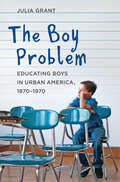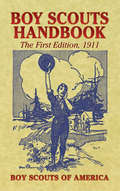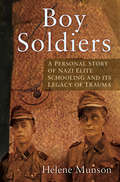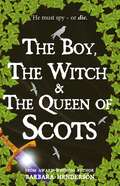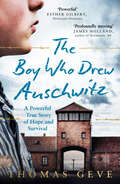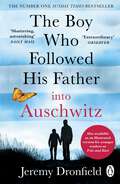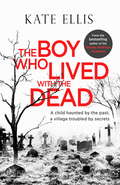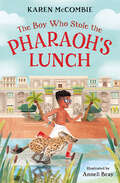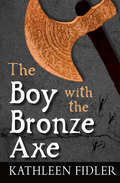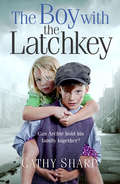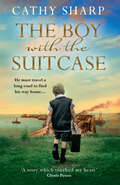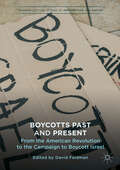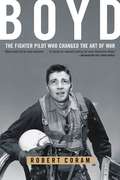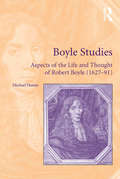- Table View
- List View
The Boy Problem: Educating Boys in Urban America, 1870–1970
by Julia GrantAmerica’s educational system has a problem with boys, and it’s nothing new.The question of what to do with boys—the "boy problem"—has vexed educators and social commentators for more than a century. Contemporary debates about poor academic performance of boys, especially those of color, point to a myriad of reasons: inadequate and punitive schools, broken families, poverty, and cultural conflicts. Julia Grant offers a historical perspective on these debates and reveals that it is a perennial issue in American schooling that says much about gender and education today.Since the birth of compulsory schooling, educators have contended with what exactly to do with boys of immigrant, poor, minority backgrounds. Initially, public schools developed vocational education and organized athletics and technical schools as well as evening and summer continuation schools in response to the concern that the American culture of masculinity devalued academic success in school. Urban educators sought ways to deal with the "bad boys"—almost exclusively poor, immigrant, or migrant—who skipped school, exhibited behavioral problems when they attended, and sometimes landed in special education classes and reformatory institutions. The problems these boys posed led to accommodations in public education and juvenile justice system.This historical study sheds light on contemporary concerns over the academic performance of boys of color who now flounder in school or languish in the juvenile justice system. Grant's cogent analysis will interest education policy-makers and educators, as well as scholars of the history of education, childhood, gender studies, American studies, and urban history.
Boy Republic: Patrick Pearse and Radical Education
by Dr Brendan WalshPatrick Pearse, teacher, poet, and one of the executed leaders of the 1916 Rising has long been a central figure in Irish history. The book provides a radically new interpretation of Patrick Pearse’s work in education, and examines how his work as a teacher became a potent political device in pre-independent Ireland. The book provides a complete account of Pearse’s educational work at St. Enda’s school, Dublin where a number of insurgents such as William Pearse, Thomas McDonagh and Con Colbert taught. The author draws upon the recollections of past-pupils, employees, descendants of those who worked with Pearse, founders of schools inspired by his work - including the descendants of Thomas McSweeny and Louis Gavan Duffy – and a vast array or primary source material to provide a comprehensive account of life at St. Enda’s and the place of education within the ‘Irish-Ireland’ movement and the struggle for independence.
Boy Scouts Handbook: The First Edition, 1911 (Dover Books On Americana Ser.)
by Boy Scouts of AmericaRead by presidents, scientists, and national heroes, the Boy Scouts Handbook has been used by generations of American youths. Filled with practical advice for everyone, the book contains everything from safety tips on swimming and instructions for putting up a tent to directions for making an aquarium and pointers on how to identify common North American trees.More than 200 figures and illustrations accompany valuable information on woodcrafting, camping, sailing, hiking, health and endurance, and providing first aid. But more than just a guide to outdoor life, the handbook also offers timeless observations on politeness, patriotism, and good citizenship.As useful and valid today as it was when first published nearly 100 years ago, the Boy Scouts Handbook will delight Americana enthusiasts as much as it will be treasured by collectors and nature lovers.
Boy Soldiers: A Personal Story of Nazi Elite Schooling and its Legacy of Trauma
by Helene MunsonAt the end of the Second World War, hundreds of thousands of German children were sent to the front lines in the largest mobilisation of underage combatants by any country before or since. Hans Dunker was just one of these children. Identified as extremely gifted aged 9, he left his home in South America in 1937 in pursuit of a ‘proper’ education in Nazi Germany. Instead, he and his schoolfriends, lacking adequate training, ammunition and rations, were sent to the Eastern Front when the war was already lost in the spring of 1945. Using her father’s diary and other documents, Helene Munson traces Hans’ journey from a student at Feldafing School to a soldier fighting in Zawada, a village in present-day Czech Republic. What is revealed is an education system so inhumane that until recently, post-war Germany worked hard to keep it a secret. This is Hans’ story, but also the story of a whole generation of German children who silently carried the shame of what they suffered into old age. It reveals the true cost and long-lasting impacts of such experiences – not just to them, but also to their families and future generations, a warning to a world where thousands of child soldiers are still sent to fight in armed conflicts.
The Boy, The Witch and The Queen of Scots
by Barbara HendersonNo. Not the Palace. Anywhere but the Palace. 12-year-old Alexander Buchan was once content, training as a falconer at Strathbogie Castle in Huntly. But when his Earl sends him to Edinburgh to the court of the newly arrived Mary, Queen of Scots, the boy finds himself lured into a world of intrigue, terror and treachery. Alexander knows right from wrong, but how can he hope to outwit the Earl's murderous messenger? Surely no one can defy such a powerful master whose wife is rumoured to be a witch! Soon, more than the boy's own life is at stake: his friend Lizzie is arrested and the the angry clouds of Reformation Scotland gather around the young Queen. It seems that Alexander must spy – or die.
The Boy Who Drew Auschwitz: A Powerful True Story of Hope and Survival
by null Thomas Geve‘We felt an urge to document what we had witnessed. If we who had experienced it, I reasoned, did not reveal the bitter truth, people simply would not believe the extent of the Nazis’ evil. I wanted to share our life, the events and our struggle to survive.’ Thomas Geve was just 15 years old when he was liberated from Buchenwald concentration camp on 11 April 1945. It was the third concentration camp he had survived. Upon arrival at Auschwitz- Birkenau, Thomas was separated from his mother and left to fend for himself in the men’s camp of Auschwitz I, at the age of 13. During the 22 months he was imprisoned, he was subjected to, and forced to observe first-hand, the inhumane world of Nazi concentration camps. On his eventual release Thomas felt compelled to capture daily life in the death camps in more than eighty profoundly moving drawings. Infamous scenarios synonymous with this dark period of history were portrayed in poignant but simplistic detail with extraordinary accuracy. Despite the unspeakable events he experienced, Thomas decided to become an active witness and tell the truth about life in the camps. He has spoken to audiences from around the world and continues to raise awareness about the Holocaust. The Boy Who Drew Auschwitz presents a rare living testimony through the eyes of a child who had the unique ability to observe and remember every detail around him and chose to document it all.
The Boy Who Followed His Father into Auschwitz: The Sunday Times Bestseller
by Jeremy DronfieldThe inspiring true story of a father and son's fight to stay together and survive the Holocaust, for anyone captivated by The Choice and The Tattooist of Auschwitz. _______Where there is family, there is hope . . . Vienna, 1939. Nazi police seize Gustav Kleinmann, a Jewish upholsterer and his son, Fritz, and send the pair to Buchenwald in Germany. There began an unimaginable ordeal that saw the pair beaten, starved and forced to build the very concentration camp they were held in.When Gustav was set to be transferred to Auschwitz, a certain death sentence, his son refused to leave his side. Throughout the horrors they witnessed and the suffering they endured, there was one constant that kept them alive: the love between father and son.Based on Gustav's secret diary and meticulous archive research, this book tells their incredible story for the first time - a story of courage and survival unparalleled in the history of the Holocaust.The Boy Who Followed His Father into Auschwitz is a reminder of both the best and the worst of humanity, the strength of family ties, and the power of the human spirit.
The Boy Who Lived with the Dead (Albert Lincoln #2)
by Kate EllisA child haunted by the past. A village troubled by secrets.'A powerful story of loss, malice and deception' Ann CleevesThe second historical thriller in the Albert Lincoln series by bestselling crime writer Kate Ellis. 1920. Scotland Yard detective DI Albert Lincoln is still reeling from the disturbing events of the previous year when he's called away from London to a new case in the North West of England. Before the War he led the unsuccessful investigation into the murder of little Jimmy Rudyard in the village of Mabley Ridge. Now a woman has been murdered there and another child is missing, the sole witness being a traumatised boy who lives in a cemetery lodge. Albert is determined that this time him he will find the truth . . . and the missing child.When Albert delves into the lives of the village residents he uncovers shocking secrets and obsessions. Then, as more bodies are discovered, he realises that his young witness from the cemetery lodge is in grave danger, from somebody he calls 'the Shadow Man'.As Albert discovers more about the victims he finds information that might bring him a step closer not only to Jimmy's killer but to solving a mystery of his own: the whereabouts of his lost son.What readers are saying about The Boy Who Lived with the Dead:'Outstanding' Goodreads reviewer, 5 stars'A fantastic read which kept me guessing right until the last few pages' Goodreads reviewer, 5 stars'Superb!' Goodreads reviewer, 5 stars'Compulsive reading . . . very cleverly constructed with plenty of twists' Goodreads reviewer, 5 stars'Hard to put the book down' Goodreads reviewer, 5 stars'[Kate Ellis] must be a genius' Goodreads reviewer, 5 stars'Excellent' Goodreads reviewer, 5 stars
The Boy Who Stole the Pharaoh's Lunch
by Karen McCombieSeth learns some important life lessons when he's transported back to Ancient Egypt in this absorbing time-slip adventure from bestselling author Karen McCombie.
The Boy Who Would Be Shakespeare: A Tale of Forgery and Folly
by Doug StewartIn the winter of 1795, a frustrated young writer named William Henry Ireland stood petrified in his father's study as two of England's most esteemed scholars interrogated him about a tattered piece of paper that he claimed to have found in an old trunk. It was a note from William Shakespeare. Or was it?In the months that followed, Ireland produced a torrent of Shakespearean fabrications: letters, poetry, drawings-even an original full-length play that would be hailed as the Bard's lost masterpiece and staged at the Drury Lane Theatre. The documents were forensically implausible, but the people who inspected them ached to see first hand what had flowed from Shakespeare's quill. And so they did.This dramatic and improbable story of Shakespeare's teenaged double takes us to eighteenth century London and brings us face-to-face with history's most audacious forger.
The Boy with Blue Trousers
by Carol JonesOn the goldfields of 19th-century Australia, two very different girls are trying to escape their past. 1856, China. In the mulberry groves of the Pearl River Delta, eighteen-year-old Little Cat carries a terrible secret. And so, in disguise as a boy in blue trousers, she makes the long and difficult passage to Australia, a faraway land of untold riches where it is said the rivers run with gold. 1857, Australia. Violet Hartley has arrived off the boat from England, fleeing scandal back home. Like the Chinese immigrants seeking their fortunes on the goldfields, Violet is seduced by the promise of a new frontier. Then she meets Little Cat, a woman who, like her, is trying to escape her past. As their fates inextricably, devastatingly entwine, their story becomes one of freedom, violence, love and vengeance, echoing across the landscapes of two great continents.
The Boy With The Bronze Axe (Kelpies)
by Kathleen FidlerKathleen Fidler's classic story is set in the ancient Stone Age village of Skara Brae on Orkney. This is a fascinating and vividly portrayed story of life nearly 3,000 years ago. Kali and Brockan are in trouble. They have been using their stone axes to chip limpets off the rocks, but they've gone too far out and find themselves trapped by the tides. Then, an unexpected rescuer appears, a strange boy in a strange boat, carrying a strangely sharp axe of a type they have never seen before. Conflict arises as the village of Skara must decide what to do with the new ideas and practices that the boy brings. As a deadly storm threatens, the very survival of the village is in doubt. Step back into the Stone Age and learn about the daily life and rituals of the ancient village of Skara Brae in this compelling, fictional account of the famous Orkney settlement. Vivid descriptions and accurate historical details bring the village to life and make this an ideal choice for those studying the Stone Age curriculum.
The Boy with the Bronze Axe (Kelpies Ser.)
by Kathleen FidlerKathleen Fidler's classic story is set in the ancient Stone Age village of Skara Brae on Orkney. This is a fascinating and vividly portrayed story of life nearly 3,000 years ago. Kali and Brockan are in trouble. They have been using their stone axes to chip limpets off the rocks, but they've gone too far out and find themselves trapped by the tides. Then, an unexpected rescuer appears, a strange boy in a strange boat, carrying a strangely sharp axe of a type they have never seen before.Conflict arises as the village of Skara must decide what to do with the new ideas and practices that the boy brings. As a deadly storm threatens, the very survival of the village is in doubt.Step back into the Stone Age and learn about the daily life and rituals of the ancient village of Skara Brae in this compelling, fictional account of the famous Orkney settlement. Vivid descriptions and accurate historical details bring the village to life and make this an ideal choice for those studying the Stone Age curriculum.
The Boy with the Latch Key (Halfpenny Orphans #4)
by Cathy SharpHeartache and hardship in London’s East End, from the bestselling author of The Orphans of Halfpenny Street
Boycott: There Are Many Ways To Fight A War
by Colin MurphyBoycott - a word whose meaning is known the world over. But it once belonged to a man. Two brothers, Owen and Thomas Joyce, barely survive the horror of the great famine that devastated Ireland in the 1840s. But it left a lasting effect on both of them. Three decades later they are thrown together during the Land War, when evictions and landlord cruelty reach an intolerable level. But Thomas places his trust in the gun, while Owen backs the passive resistance advocated by the Land League. Captain Charles Boycott, an English land agent in Mayo, becomes the first to suffer this new form of revolt, when he and his family are ostracised. It is a David versus Goliath situation, with Boycott supported by the military, the police, the press, the British Government. How can peasants stand against an empire? And how will the two brothers reconcile their differences and confront their troubled past? A novel of brotherly love and brotherly conflict.
Boycotts Past and Present: From the American Revolution to the Campaign to Boycott Israel (Palgrave Critical Studies of Antisemitism and Racism)
by David FeldmanIn this book historians and social scientists examine boycotts from the eighteenth century to the present day. Employed in struggles against British rule in the American colonies, against racial discrimination in the United States during the Civil Rights movement, and Apartheid in South Africa, today it is Israel that is the focus of a campaign for Boycott, Divestment and Sanctions (BDS). Boycotts have featured in campaigns undertaken by labour, consumer and nationalist movements. Jews were the focus of some boycotts instigated by nationalist movements in Central and Eastern Europe and Jewish businesses were targeted by the National Socialist regime in Germany. In this collection, contributors explore the history of past boycott movements and examine the different narratives put forward by proponents and opponents of the current BDS movement directed against Israel: one which places the movement within a history of struggles for ‘human rights’; the other which regards BDS as the latest manifestation of an antisemitic tradition.
Boyd: The Fighter Pilot Who Changed the Art of War
by Robert CoramJohn Boyd may be the most remarkable unsung hero in all of American military history. Some remember him as the greatest U.S. fighter pilot ever -- the man who, in simulated air-to-air combat, defeated every challenger in less than forty seconds. Some recall him as the father of our country's most legendary fighter aircraft -- the F-15 and F-16. Still others think of Boyd as the most influential military theorist since Sun Tzu. They know only half the story. Boyd, more than any other person, saved fighter aviation from the predations of the Strategic Air Command. His manual of fighter tactics changed the way every air force in the world flies and fights. He discovered a physical theory that forever altered the way fighter planes were designed. Later in life, he developed a theory of military strategy that has been adopted throughout the world and even applied to business models for maximizing efficiency. And in one of the most startling and unknown stories of modern military history, the Air Force fighter pilot taught the U.S. Marine Corps how to fight war on the ground. His ideas led to America's swift and decisive victory in the Gulf War and foretold the terrorist attacks of September 11, 2001. On a personal level, Boyd rarely met a general he couldn't offend. He was loud, abrasive, and profane. A man of daring, ferocious passion and intractable stubbornness, he was that most American of heroes -- a rebel who cared not for his reputation or fortune but for his country. He was a true patriot, a man who made a career of challenging the shortsighted and self-serving Pentagon bureaucracy. America owes Boyd and his disciples -- the six men known as the "Acolytes" -- a great debt. Robert Coram finally brings to light the remarkable story of a man who polarized all who knew him, but who left a legacy that will influence the military -- and all of America -- for decades to come . . .
The Boyle Papers: Understanding the Manuscripts of Robert Boyle
by Michael HunterRobert Boyle (1627-91) was the most influential British scientist of the late seventeenth century. His huge archive, which has been at the Royal Society since 1769, has only recently been explored, leading to a new understanding of many aspects of Boyle's thought. This volume brings together the essential materials for understanding the Boyle Papers. It includes a revised version of Michael Hunter's fundamental study of the archive, first published in 1992, which elucidates its history and the way in which handwriting evidence can be used to identify chronological strata within it, thus making it possible to trace the development of Boyle's ideas. Other chapters deal with such components of the Papers as Boyle's 'workdiaries' and his projected Paralipomena; another uses material from the archive to illuminate the making of a key work by Boyle, his Free Inquiry into the Vulgarly Receiv'd Notion of Nature; while another illustrates that, large as the archive is, it is only a part of what existed in Boyle's lifetime. Parts of the content have been published before, but they are here presented in revised and fully indexed form. Lastly, the volume includes a completely revised version of the catalogue of the Boyle Papers, Letters and ancillary manuscripts originally published in 1992, updating it by tabulating the extensive use of the archive made in recent years in connection with the publication of the definitive editions of Boyle's Works and Correspondence (1999-2001). In all, the volume will be indispensable to anyone with a serious interest in Boyle.
The Boyle Papers: Understanding the Manuscripts of Robert Boyle
by Michael HunterRobert Boyle (1627-91) was the most influential British scientist of the late seventeenth century. His huge archive, which has been at the Royal Society since 1769, has only recently been explored, leading to a new understanding of many aspects of Boyle's thought. This volume brings together the essential materials for understanding the Boyle Papers. It includes a revised version of Michael Hunter's fundamental study of the archive, first published in 1992, which elucidates its history and the way in which handwriting evidence can be used to identify chronological strata within it, thus making it possible to trace the development of Boyle's ideas. Other chapters deal with such components of the Papers as Boyle's 'workdiaries' and his projected Paralipomena; another uses material from the archive to illuminate the making of a key work by Boyle, his Free Inquiry into the Vulgarly Receiv'd Notion of Nature; while another illustrates that, large as the archive is, it is only a part of what existed in Boyle's lifetime. Parts of the content have been published before, but they are here presented in revised and fully indexed form. Lastly, the volume includes a completely revised version of the catalogue of the Boyle Papers, Letters and ancillary manuscripts originally published in 1992, updating it by tabulating the extensive use of the archive made in recent years in connection with the publication of the definitive editions of Boyle's Works and Correspondence (1999-2001). In all, the volume will be indispensable to anyone with a serious interest in Boyle.
Boyle Studies: Aspects of the Life and Thought of Robert Boyle (1627-91)
by Michael HunterThe significance of Robert Boyle (1627-91) as the most influential English scientist in the generation before Newton is now generally acknowledged, but the complexity and eclecticism of his ideas has also become increasingly apparent. This volume presents an important group of studies of Boyle by Michael Hunter, the leading expert on Boyle’s life and thought. It forms a sequel to two previous books: Hunter’s Robert Boyle: Scrupulosity and Science (2000) and The Boyle Papers: Understanding the Manuscripts of Robert Boyle (2007). Like them, it conveniently brings together material otherwise widely scattered in essay volumes and academic journals, while nearly a third of the book’s content is hitherto unpublished. The collection opens with a substantial introduction that places the studies that follow in the context of existing studies of Boyle; appended to it is an annotated edition of Boyle’s telling list of desiderata for science. The next three essays comprise a group of essentially biographical studies, exploring various aspects of Boyle’s life and intellectual evolution, after which three others provide further evidence of the ’convoluted’ Boyle divulged in Robert Boyle: Scrupulosity and Science. Finally, we have two chapters, one hitherto published only in French and the other not at all, which throw important light on topics that preoccupied Boyle in the last few years of his life - the supernatural and the exotic. Together, these essays add greater depth to our understanding of Boyle, both as an individual and as a natural philosopher.
Boyle Studies: Aspects of the Life and Thought of Robert Boyle (1627-91)
by Michael HunterThe significance of Robert Boyle (1627-91) as the most influential English scientist in the generation before Newton is now generally acknowledged, but the complexity and eclecticism of his ideas has also become increasingly apparent. This volume presents an important group of studies of Boyle by Michael Hunter, the leading expert on Boyle’s life and thought. It forms a sequel to two previous books: Hunter’s Robert Boyle: Scrupulosity and Science (2000) and The Boyle Papers: Understanding the Manuscripts of Robert Boyle (2007). Like them, it conveniently brings together material otherwise widely scattered in essay volumes and academic journals, while nearly a third of the book’s content is hitherto unpublished. The collection opens with a substantial introduction that places the studies that follow in the context of existing studies of Boyle; appended to it is an annotated edition of Boyle’s telling list of desiderata for science. The next three essays comprise a group of essentially biographical studies, exploring various aspects of Boyle’s life and intellectual evolution, after which three others provide further evidence of the ’convoluted’ Boyle divulged in Robert Boyle: Scrupulosity and Science. Finally, we have two chapters, one hitherto published only in French and the other not at all, which throw important light on topics that preoccupied Boyle in the last few years of his life - the supernatural and the exotic. Together, these essays add greater depth to our understanding of Boyle, both as an individual and as a natural philosopher.
The Boys' and Girls' Plutarch
by Plutarch John S. WhiteParts of The "Lives" of Plutarch edited for boys and girls with introduction by John S. White, LL.D., Head-Master Berkeley School
Boys and their Toys: Masculinity, Class and Technology in America (Hagley Perspectives on Business and Culture)
by Roger HorowitzNegotiating the divide between "respectable manhood" and "rough manhood" this book explores masculinity at work and at play through provocative essays on labor unions, railroads, vocational training programs, and NASCAR racing.
Boys and their Toys: Masculinity, Class and Technology in America (Hagley Perspectives on Business and Culture)
by Roger HorowitzNegotiating the divide between "respectable manhood" and "rough manhood" this book explores masculinity at work and at play through provocative essays on labor unions, railroads, vocational training programs, and NASCAR racing.
